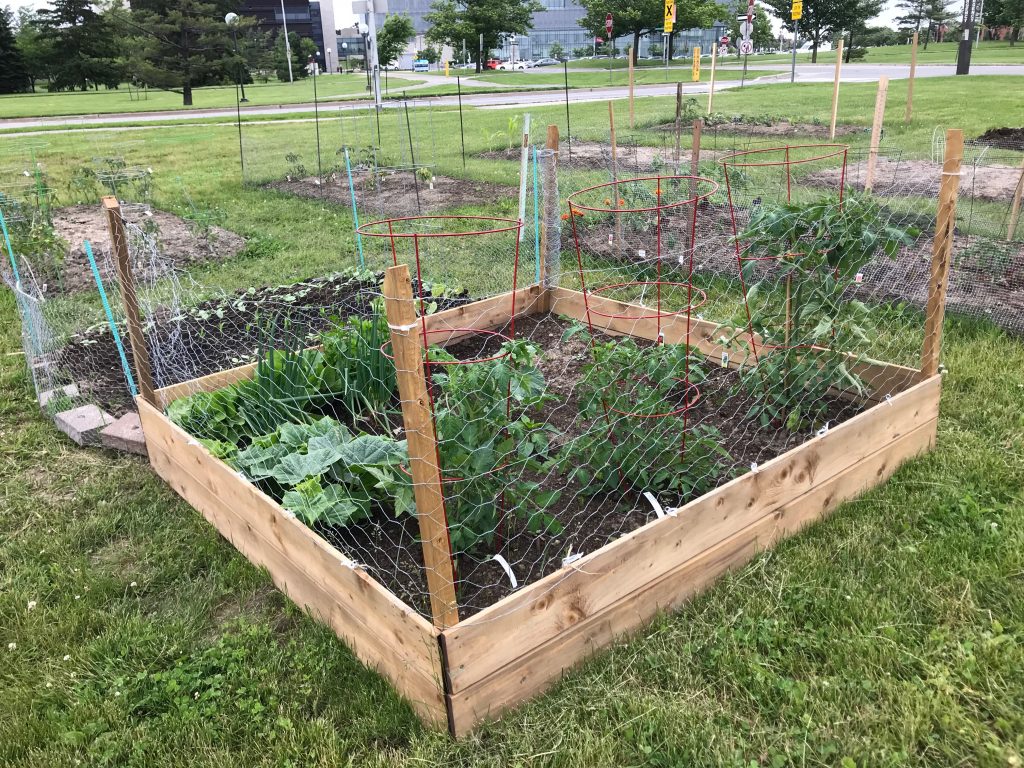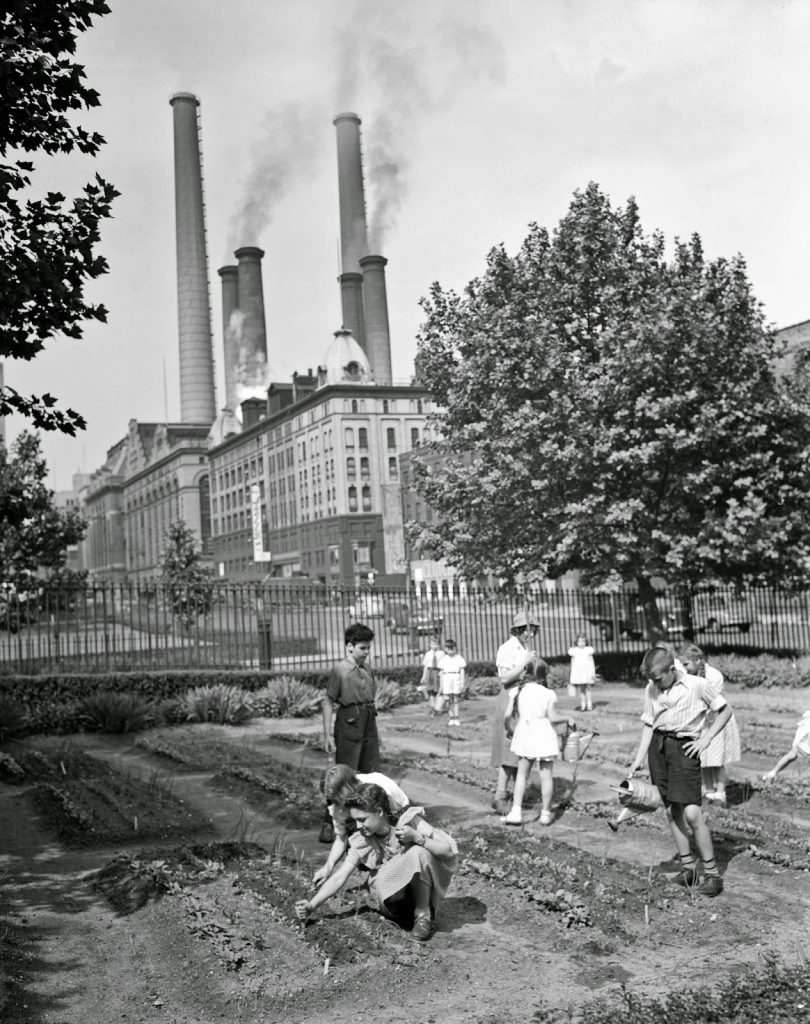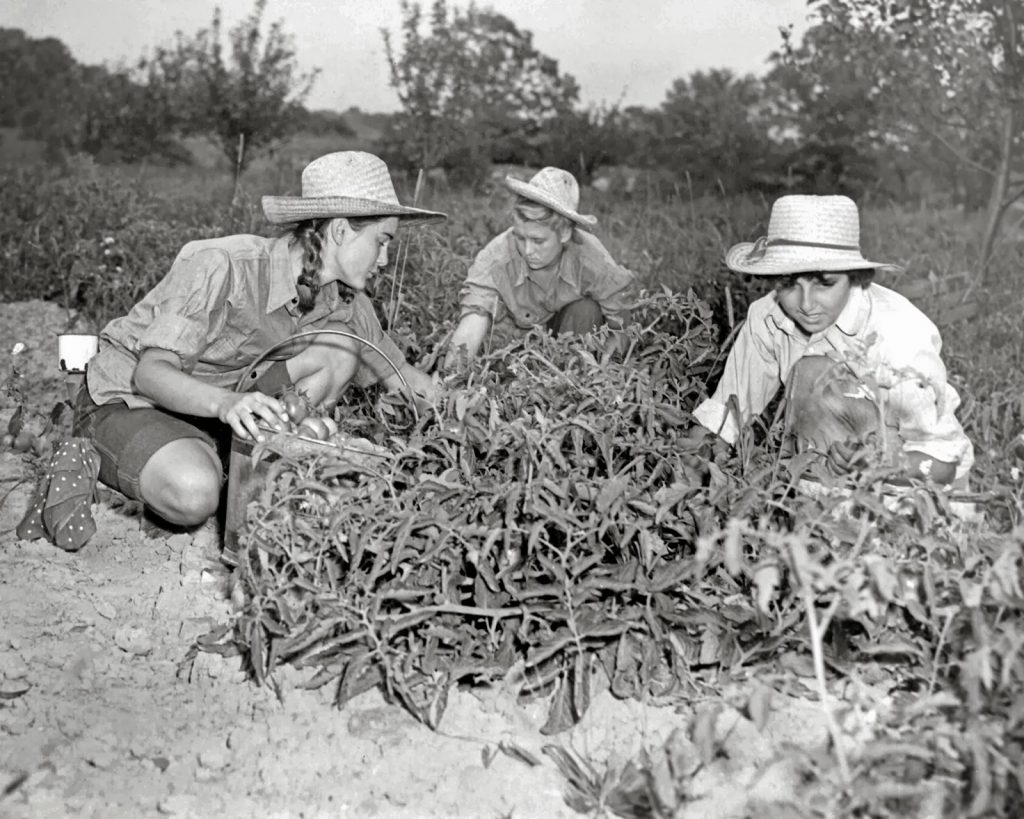By Goran Irandost
HIST4P50 #BrockHistoricalGardens
Goran and Kaylin will be providing free tours of their historical gardens on Wednesday, Aug. 28 from 4:15 to 5 pm. Come by and learn more about their plants and gardening process and taste some of the results!

Some of the plots in Brock’s community garden.
A community garden is exactly what its name implies; a piece of land gardened by a group of people. The types of gardens within these pieces of land may vary, but nonetheless, based on some research and my own personal experience, these community gardens typically involve individuals who work with one another to help each other succeed in their harvests. The very idea of a community garden can be dated back to the late eighteenth century in which owners would allocate certain pieces of land to tenants for the purpose of gardening.[1] Similar to the victory gardens that have been discussed throughout the following course, these early community gardens were focused on growing produce to supplement one’s diet.[2] The purpose of many of these gardens was to be self-sufficient; vegetables such as potatoes were of great significance as they were relatively easy to grow and an important part of one’s diet during this period.[3]

Edward Meyer Children’s School victory gardens on First Avenue, New York NY, 1944.
Although community gardens can be traced back to Europe in the eighteenth century, its popularity truly rose during the first and second World Wars. Countries such as Britain and the United States emphasized a need to grow one’s own vegetables to help maintain a healthy diet during the war. A great deal of effort was made to promote efficient gardening techniques and create a large enough supply that would help ease the effects of the rations on certain foods. Additionally, these gardens were linked to the war itself through the use of propaganda campaigns that focused on establishing these victory gardens as patriotic and for the good of the country. The extent of these campaigns were far-reaching and had a tremendous impact on society as millions of gardens were grown during the second World War alone. It is important to note that these governments did not trust their citizens knowledge of proper gardening techniques, and although both the United States and Britain promoted such teachings, the community gardens were another way to nullify these limitations and truly maximize harvests as individuals could help one another maintain the health of their crops.[4]

American Girl Scouts tend a victory garden.
The recent rise in popularity of community gardens can be attributed to a variety of reasons that are fairly different than what had occurred during both the World Wars. The need for an alternate source of food still persists, but according to Rachel Obordo of the Guardian, these community gardens are important in providing access to fresh fruits and vegetables in areas that are lacking economically.[5] Additionally, these community gardens also provide opportunities for individuals to socialize and engage in a group activity that rewards hard work with both a good harvest and important life skills.[6] In the age of social media and video games, it is sometimes necessary to re-connect with the more simplistic aspects of life in order to find a new and better perspective on life. These community gardens provide just that and its recent popularity can be understood as simply a way to reconnect with others on a more personal level.

Torosian Park community garden, St. Catharines, ON.
There are several community gardens in both the Niagara and St.Catharines regions. There exists some gardens in Niagara Falls that focus on growing fresh produce to donate to others in times of emergency. These gardens are promoted on the “Project Share” website and are a great way to help feed those in need through their emergency food program (link for website).[7] Unfortunately, I have only had the opportunity to visit one community garden prior to taking the following course. This garden was located in St.Catharines near Ventura Drive and was a community filled with local residents who all grew their own plants as an alternative fresh food source. I have a few cousins that had resided in that area who had a garden on that plot. In my very first observations of this community garden, it was very apparent how much my cousins relied upon one another to maintain the quality of their plants as they consistently watered and nurtured each other crops throughout the summer. They did such things not because they were asked to do so, but because helping one another makes working within a community garden far more enjoyable and much easier.
Having experienced life in a community garden, I cannot say that I have not enjoyed my time thus far. From the beginning of the course to the present day, I have not had a single bad experience working in my garden. My interactions with the other gardeners on the plot have been limited, but the help I have received from my professor and coworkers has been a key part of my gardens success.
I have been unable to tend to my garden as often as I would like throughout the summer due to a busy schedule. On a good week, I have visited the garden between two or three times, but most of the time I have only been able to attend once a week as part of the routine check-up. This has probably impacted the growth of my plants on some level. However, Professor Vlossak has been kind enough to water my plants upon her visits to the garden which has been a great help. She has also provided some natural fertilizer to help with the growth of my tomato plants which had looked slightly unhealthy.
Additionally, some of my coworkers were very helpful in the early stages of planning for my garden. These co-workers all have years of experience in gardening and provided information in regards to which plants were good to grow (the late start to the course had me slightly worried), and what to expect throughout the whole process.
Additionally, I have come to really enjoy conversations regarding gardening in general as it is not an exact science; people utilize many different methods and grow plants in their own unique way. One of the more interesting stories came from a coworker who stated that they played music for their plants on a regular basis. They did not promote this as a useful gardening technique, but simply something they found to be enjoyable and part of their growing process.
With all that has been learned throughout this course, the only thing preventing me from joining a community garden is the lack of time I have had to properly look after my garden. As someone that tries to enjoy new experiences, gardening has been both peaceful and extremely informative and is something that I look forward to continuing in my home in the future.
[1] N, Flavell. “Urban Allotment Gardens in the Eighteenth Century: The Case of Sheffield.” The Agricultural History Review 51, no. 1 (2003): 96.
[2] Ibd 103-104
[3] Ibd 104
[4] Ginn, Franklin, Ginn. “Dig for Victory! New histories of Wartime Gardening in Britain”.Journal of Historical Geography. 298
[5] Rachel Obordo. “Fresh, Free and Beautiful: The Rise of Urban Gardening”. https://www.theguardian.com/world/2018/jun/07/fresh-free-and-beautiful-the-rise-of-urban-gardening
[6] Ibd
[7]“Community Gardens”. https://www.projectshare.ca/community-gardens
Bibliography
Ginn, Franklin. “Dig for Victory! New histories of Wartime Gardening in Britain”. Journal of Historical Geography
Flavell, N. “Urban Allotment Gardens in the Eighteenth Century: The Case of Sheffield.” The Agricultural History Review 51, no. 1 (2003): 95-106. http://www.jstor.org/stable/40275844.
Rachel Obordo. “Fresh, Free and Beautiful: The Rise of Urban Gardening”. https://www.theguardian.com/world/2018/jun/07/fresh-free-and-beautiful-the-rise-of-urban-gardening
“Community Gardens”. https://www.projectshare.ca/community-gardens



